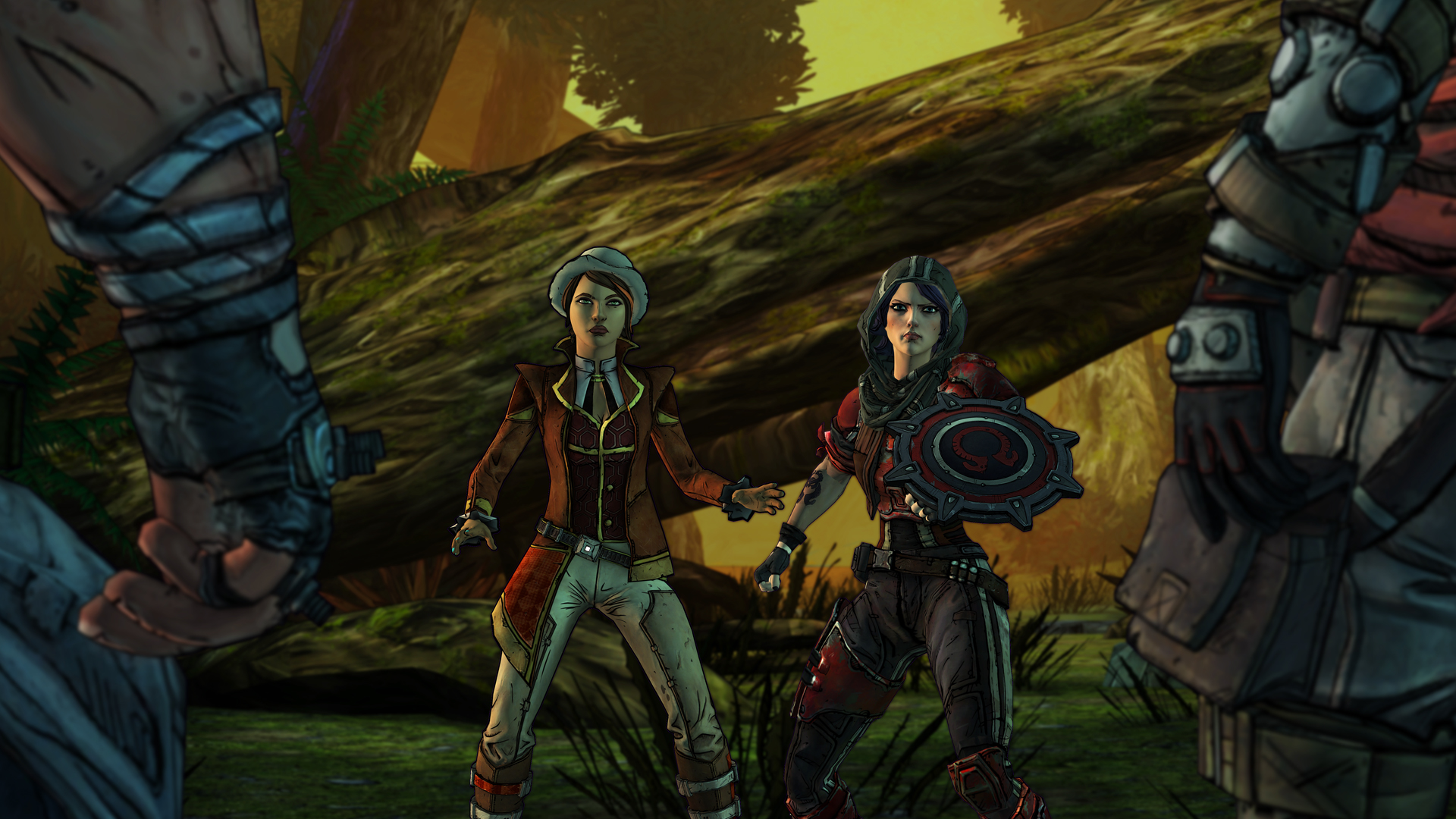
2015: The Year of Choices
Choose your path in today’s retrospective, with Sunset, Until Dawn, Life is Strange, and Tales from the Borderlands.
Sunset
Angela Burnes, the protagonist of Tale of Tale’s Sunset, exists in liminality. She is a African-American living in the South American country of Anchuria that’s on the verge of a revolution. She was an engineer, but is now a housekeeper. Yet she is also a spy, traitor, and anarchist.
Burnes works on holidays and feast days, tidying up the apartment of an art collector with governmental ties, Gabriel Ortega. Though she does nothing but repetitive chores, the game gives you a choice on how to carry them out. Burnes can be flirtatious as she lays out a new bedspread or she can be more cold and controversial by hanging the rebel’s flag on a wall.
The penthouse is both a prison and an oasis. Burnes is awash in spectacular paintings and sculptures that distract her from the current affairs. However, they’re also a reminder that the public won’t see these works as they kill each other on the city streets. Do you sit in an armchair as the sun sets and write in a diary while listening to Austin Wintory’s diegetic score? Or do you finish the day’s task as quickly as possible and leave? Each week she becomes more comfortable, yet restless, in the home that isn’t her home.
In the end, Burnes frees herself from limbo as a sun rises over the jungle in the most peaceful game about war I’ve ever played.
Jefferson Geiger is a journalist and crtic from Colorado. His work can be found at GameSpot and Memory Insufficient. You can follow him on Twitter or at his website.

Until Dawn
Until Dawn’s appeal to the butterfly effect for narratives and character relations grabbed my friends and I instantly. For us, this was a couch co-op game to play with a group – yelling out dialogue choices, advising what paths to take, and crying out at every character death. The compelling hierarchy of choices, character-to-character interactions, and quick time events made for a storyline well supported by its mechanics. As a group, we felt that we had an obligation to these characters – to ensure that they reached dawn safely. Needless to say, we felt devastated each time we lost another character to the monsters in the dark.
Although the game references the butterfly effect a bit too much, it does successfully make the player feel the gravity of each seemingly small choice. Until Dawn tells the player every time a choice they’ve made has started a new series of events – everything from choosing to speak to someone, routes in the woods, and inspecting elements in the environment. Although a bit excessive, my friends and I constantly checked our butterfly effect trees to make sure we hadn’t messed up somewhere along the way. Our stomachs would get queasy when we would read something seemingly benign like forgetting to check a phone as a recorded event. Giving gravity to each interaction ensured that the player never forgot the importance and urgency of the situation the characters were in.
Riddled with quick-time events, choices and paths, and an unraveling story of betrayal and monsters in the woods, Until Dawn made for a riveting game to share and play with friends. Poking fun at characters, hastily discussing what paths to take, and holding our breath at crucial moments together was one of the best parts of my experience. Until Dawn gave me a compelling story of mystery, murder, and monsters and never let me forget the gravity and lasting effects of each little choice we made.
Mahreen Fatima embodies creative chaos as a 3D environment artist, game designer, and writer. Starting with a controller, she spiraled out of control into a life of creating art, making games, and writing opinions. Her musings can be found on Twitter and her work on her website.

Life is Strange
For five episodes, I went back and forth on Life Is Strange. I loved it, I hated it. The writing was solid and the characters were building, but oh, some of the dialogue. The fetch quests. The tropes. No matter how I railed about this or that, the game stuck with me at every turn. I spent months thinking about the story, the implications, the chasms that opened after this choice or that. Whole branches of the game flowered for some and withered for others. Small decisions changed major views on relationships. With no timer, I agonized over choices, especially once I realized how much weight each one might carry, but by the end, so much was flipped around. Decisions I’d been convinced were right turned out to be very, very wrong, but by then, nothing could be repaired. The power to change time could only do so much.
The driving mechanic in Life Is Strange that allows the main character to rewind time is a funny thing, allowing us to test the waters and see how things go, but in the end, all it really does is show us how little we can see and understand, regardless of the control we think we have. I spent so much time circling back and considering in Life Is Strange, and in the end, I’d gone almost nowhere, even though I’d seen so much.
At times a clunky adventure game with predictable puzzles, at others a high school soap opera, or thinly veiled philosophy problem, Life Is Strange is far from perfect, and yet it was the game that touched me most in 2015, a game that continues to touch me, a game I may never forget. Life Is Strange made me laugh, made me yell in horror and frustration, and made me weep more than once. I felt moments of tension deep in my gut, and in those moments, I forgot plot holes and problems and remembered that nothing is ever quite perfect. It’s what we take with us after that matters, and there, maybe, Life Is Strange is perfect after all.
Alisha Karabinus is a PhD student in rhetoric and composition at Purdue University, focusing on games studies and digital identity. You can find her at Not Your Mama’s Gamer or on Twitter if you’re so inclined.

Tales from the Borderlands
It all started with the music. The music that almost made sure I didn’t start the game. It was just too good. I sat on the start screen staring at the vividly colored characters and landscape and listening to the jazz fusion theme song. At some point I finally pressed start because it’s just what we do, we start videogames. Tales from the Borderlands starts by telling the mercenary history of Pandora and Handsome Jack before jumping into the story of Rhys, the Hyperion “company man”, whose own mercenary aspirations have led to his being bound and dragged through the desert by a masked captor while telling the story of the Gortys Project. And this is what makes Tales from the Borderlands different from other next-gen point and click adventure games in the Telltale library. We start by playing through a series of flashbacks and our in-game choices are telling the story of Rhys and Fiona, a female con artist with aspirations to be a vault hunter. There is some cold comfort in knowing that no matter what choices you make in the game you will come out the other side alive because you are there now.
I have to admit that I own several different games in the Borderlands series because I was always drawn to the characters and the prospect of vault hunting, but I had never played more than a couple of hours total because they couldn’t hold my interest. It always felt like something was missing and that something was the story. Tales from the Borderlands gave me what I was looking for in the original Borderlands shooters, the stories of people. And what is even more appealing about these stories is the diversity of the people who live them. We have characters of color, queer characters, older characters and all of their stories speak to that diversity in a way that adds depth to the pre-existing lore of Pandora and the emerging narratives of Rhys and Fiona. And the game is just funny, and I don’t mean random snicker kind of funny, but many of the jokes and references are laugh-out-loud funny (look for a reference to the 1989 film Harlem Nights in episode three). All things considered, what I found most interesting about Tales was that rather than scratching the Borderlands itch for me, it made me want to go back and play the original shooters even more because now the characters meant something to me. I know the lore, I know what drives the characters that I engage with.
I have never been a fan of episodic games. I am a bit of a binge gamer. If I find a game that draws me in it is not unusual for me to play that game several hours a day every day until I’ve finished it. The individual episodes of Tales from the Borderlands lasted about 2 hours each and absolutely left me yelling at my television at the end of each one. I needed to know what happened next, how things shook out, how the story was going to progress or ultimately end (or at least lead me to the point of being bound and dragged through the desert). There is something special to these stories and I think that it comes from the diversity in the characters and the ways that their stories are told.
Samantha Blackmon has been gaming for more than 30 years. It took 20 years to turn a guilty pleasure into research, but she got it done. Now she does rhetoric and game studies at Purdue. Her interest lays in critique of identity and identity formation in game studies. You can find her writing and podcasting at Not Your Mama’s Gamer and on Twitter.